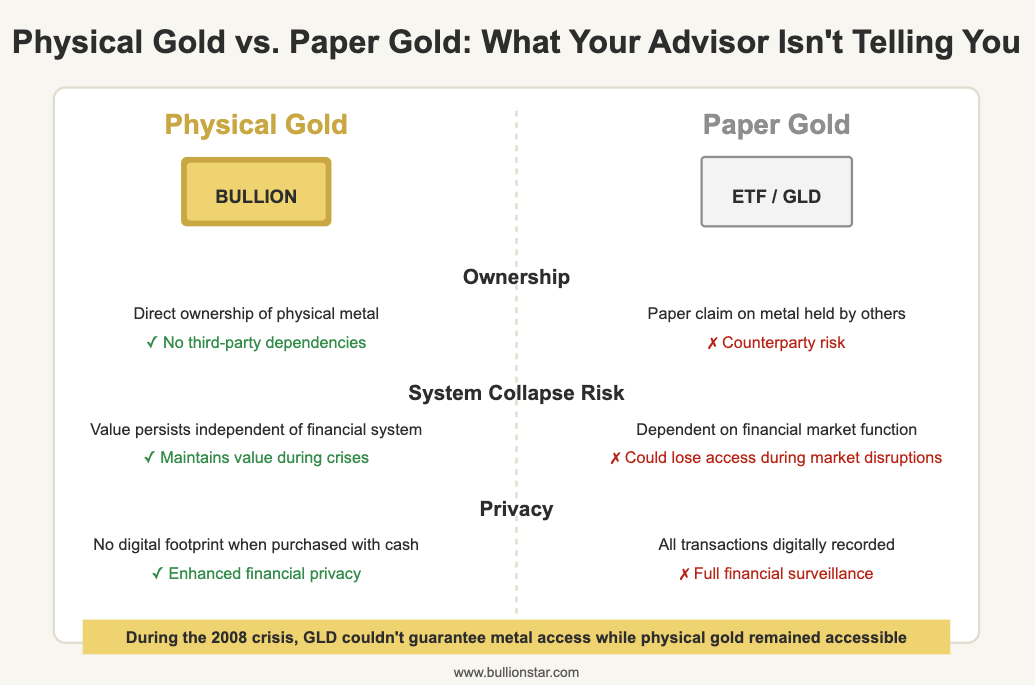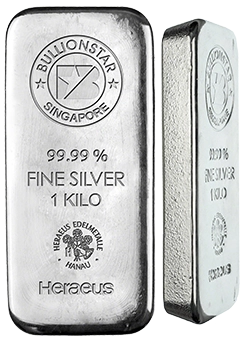The Golden Truth: How Financial Advisors’ Silence on Bullion Could Cost You Your Wealth
As banking systems falter, currencies devalue, and global conflicts escalate, millions of Americans hold savings and portfolios that are dangerously exposed to systemic risks—all because financial advisors intentionally exclude one critical asset class: physical gold bullion.
This omission leaves hardworking savers just one market crash away from devastating losses while denying them the wealth preservation power that has safeguarded families through wars, depressions, and currency collapses for over 5,000 years.
Despite gold’s 5,000-year history as a monetary metal and store of value, less than 2% of Americans own physical gold as an investment, and even fewer have been advised to do so by their financial professionals.
This widespread omission isn’t merely coincidental. There are specific, structural reasons why the financial advisory industry largely steers clients away from physical precious metals.
Today, we’ll explore what many financial advisors aren’t telling you about gold bullion – and why this information gap could leave your savings and portfolio vulnerable.

The Commission Conflict: How Advisor Compensation Discourages Gold Recommendations
The modern financial advisory business operates primarily on either fee-based or commission-based models. Neither structure incentivizes the recommendation of physical gold bullion.
Fee-based advisors typically charge a percentage of assets under management (AUM), commonly 1-1.5% annually. Physical gold stored outside the financial system—whether in a private vault or personal safe—generates no ongoing fees for the advisor. Allocating $100,000 to physical gold instead of managed funds represents $1,000-1,500 in lost annual revenue per client.
Commission-based advisors face similar disincentives. While selling mutual funds, annuities, and insurance products can generate up to 6% commissions, the margins on physical precious metals typically range from 1-3%, often as one-time transactions rather than recurring revenue streams.
This compensation structure creates an inherent conflict of interest. Even well-intentioned advisors operating under fiduciary standards face economic pressure to recommend paper assets over physical bullion.
Physical Gold vs. Paper Gold: A Critical Distinction Your Advisor May Blur
When gold does enter the conversation with financial advisors, the recommendation typically leans toward “paper gold" – financial products that track the gold price rather than provide actual ownership of the metal itself.
These include:
-
- Gold ETFs like GLD or IAU
- Gold mining stocks
- Gold futures contracts
- Gold certificates
While these instruments offer convenience and liquidity, they fundamentally differ from physical gold bullion in one crucial respect: counterparty risk. Each paper gold vehicle depends on the ongoing solvency and honesty of one or more financial intermediaries.
The popular SPDR Gold Trust (GLD) prospectus spans 40 pages of legal disclaimers and risk factors. Few advisors direct clients to read this document, which explicitly states: “The Trust may not have adequate sources of recovery if its gold is lost, damaged, stolen or destroyed."
During the 2008 financial crisis, many gold ETF holders were surprised to learn their “gold investment" didn’t guarantee access to actual metal during a liquidity crunch. Similar concerns emerged in 2020 when the spread between paper and physical gold prices temporarily widened to unprecedented levels as demand for real metal surged.

Physical gold bullion, by contrast, carries no counterparty risk when directly owned and adequately stored. This fundamental advantage rarely features in typical financial advisory conversations.
Savings & Portfolio Protection: From Market Crashes to Regime Changes
Savings & Portfolio Protection Beyond Correlation Statistics
When gold is discussed in mainstream financial planning, it’s typically framed in terms of its correlation (or lack thereof) with other asset classes. While this statistical approach has merit, it drastically undersells gold’s primary function: monetary insurance against both immediate market risks and long-term systemic challenges.
Historical data demonstrates gold’s exceptional performance during periods of financial stress:
-
- During the 2008 financial crisis, gold rose 25% while the S&P 500 fell 38%
- In 2020’s pandemic market shock, gold dropped just 3% during the initial selloff compared to the S&P 500’s 34% plunge
- During the regional banking crisis of March 2023, gold surged while bank stocks collapsed
- Today, as we confront unprecedented trade wars, gold has achieved new heights.
This performance pattern isn’t coincidental. Gold serves as a hedge against the financial system’s foundations: currency debasement, banking system fragility, and counterparty risk.
Standard savings and portfolio modeling tools don’t adequately capture these systemic risks, focusing on historical correlations during normal market conditions.
Wealth Preservation Through Generations and Regime Changes
While conventional advisors focus on quarterly performance metrics, gold’s most powerful property extends far beyond short-term market movements. Throughout history, gold has preserved wealth across generations, political upheavals, and complete monetary system resets.
Standard financial planning operates within assumptions of political and economic stability. History suggests such stability isn’t guaranteed across generational timeframes.
Throughout the 20th century, numerous nations experienced currency collapses, asset confiscations, banking system failures, and political revolutions that decimated paper wealth. From the German hyperinflation of the 1920s to the Argentine currency crises of the early 2000s, from the Cyprus bank deposit confiscation of 2013 to the ongoing Venezuelan economic collapse – financial system failures recur with surprising regularity..
In each case, physical gold stored outside the banking system preserved purchasing power while locally-denominated financial assets evaporated.
The same properties that make gold perform well during market crashes – its status outside the financial system and universal recognition of value – also make it exceptional during more extreme scenarios that few advisors are comfortable discussing with clients, despite their historical frequency.
Few advisors consider gold insurance rather than merely another asset class, perhaps because doing so would require acknowledging systemic vulnerabilities in the financial system from which they derive their livelihood.
The Privacy Advantage in an Age of Financial Surveillance
Physical gold offers a level of financial privacy increasingly rare in today’s world – a benefit seldom mentioned in conventional financial planning discussions.
Unlike virtually all financial assets, physical gold:
-
- Requires no personal information to purchase (under-reporting thresholds)
- Creates no digital transaction record when bought with cash
- Generates no statements, 1099s, or automatic reporting
- In many circumstances, gold can be transported across national borders without third-party permission (subject to customs declarations)
Legal privacy is a legitimate right that physical gold uniquely preserves. As banking privacy continues to erode worldwide, this feature of physical gold becomes increasingly valuable yet remains undiscussed mainly in mainstream financial planning.
Gold’s International Liquidity: The Universal Asset
Another underappreciated aspect of physical gold is its universal recognition and liquidity. Unlike most jurisdictionally bound financial assets, gold is a global currency recognized across borders and cultures.
This characteristic becomes invaluable during periods of capital controls or banking restrictions.
When Cyprus froze bank accounts in 2013, Greece restricted ATM withdrawals in 2015, and Lebanon enacted informal capital controls in 2019, those holding physical gold retained access to their wealth, while those with only bank deposits encountered significant restrictions.
Physical gold can be sold for local currency in virtually any country, making it an exceptional asset for those facing geopolitical uncertainty or the possibility of relocation. These benefits are rarely discussed in standard financial planning frameworks.
Storage Solutions and Security Myths
When physical gold does enter financial planning conversations, the discussion of storage often focuses exclusively on security concerns while ignoring modern storage solutions.
Professional allocated storage offers maximum security with identified bars in your name, segregated from other clients’ holdings, and fully insured. Modern home security solutions have made private storage considerably more viable than in previous eras for those preferring personal possession.
The narrative that physical gold is fundamentally difficult or dangerous to own serves financial interests that benefit from keeping client assets within the economic system. Secure, insured storage solutions exist at reasonable costs – typically 0.5-0.7% annually, less than half the fee most financial advisors charge.
At BullionStar, we offer US customers one year of complimentary secure precious metal storage
Many wealth management firms charge up to 1% in fees, not including hidden costs. Pay attention to trading fees, fund expense ratios, and custodial fees. This context shows that storage fees for precious metals are highly competitive.
A Balanced Approach to Gold Allocation
Rather than accepting the industry-standard dismissal of physical gold, consider asking your financial advisor these questions:
-
- “What specific allocation to physical gold bullion (not ETFs or mining stocks) do you recommend, and why?"
- “How would you compare the counterparty risks of gold ETFs versus allocated physical gold?"
- “What historical examples can you provide where physical gold failed to preserve purchasing power during currency crises?"
Their answers–or lack thereof–may reveal the limitations of conventional financial advisors’ wisdom regarding this ancient but enduringly relevant monetary metal. It’s little wonder many Americans turn to Costco to buy gold.
Taking Action: First Steps Toward Physical Gold Ownership
If you’re considering adding physical gold to your savings and portfolio, start with these steps:
-
- Education: Learn the fundamentals of gold as monetary insurance rather than merely another investment
- Product selection: Understand the differences between coins, bars, and various forms of bullion
- Authentication: Purchase only from reputable dealers with established track records
- Storage: Evaluate professional storage, bank safe deposit boxes, and home storage options based on your situation
- Documentation: Maintain appropriate records for potential future sale or inheritance purposes
While the financial advisory industry may have structural reasons to downplay physical gold ownership, an informed investor can make independent decisions about this unique asset class.
Gold has preserved wealth for thousands of years before modern financial planning existed—and may continue to do so long after today’s investment vehicles have been forgotten.
BullionStar: A Premium Solution for Physical Gold Ownership
For US investors seeking a trusted partner in physical gold ownership, BullionStar offers a comprehensive solution that addresses the concerns outlined in this article. Unlike many domestic dealers who simply facilitate transactions, BullionStar provides an integrated approach to precious metals ownership with several distinct advantages.
Offshore Storage for Enhanced Security and Privacy
Perhaps BullionStar’s most significant differentiator is their international vault options. Located in Singapore, one of the world’s most stable and respected financial jurisdictions, BullionStar’s vault facilities offer US investors a level of geographical diversification unavailable through domestic providers.
Singapore maintains strict banking secrecy laws and has no reporting requirements to foreign tax authorities beyond established tax treaties. This creates a legal and secure environment for asset protection that operates outside the US financial system’s increasingly complex web of regulations and reporting requirements.
BullionStar’s allocated storage means your precious metals are held in your name, segregated from others’ holdings, fully insured, and audited by respected third parties. This arrangement provides the ultimate combination of security, privacy, and legal compliance, addressing several key concerns that traditional financial advisors rarely discuss.
Vertically Integrated Business Model
Unlike many bullion dealers who operate primarily as middlemen, BullionStar’s vertically integrated approach encompasses:
-
- Direct bullion sourcing from major refineries and mints
- Rigorous authentication processes with state-of-the-art verification equipment
- Secure showroom facilities for physical inspection of products
- Proprietary storage vault operations under their direct management
- Integrated buy-back program with transparent pricing
This end-to-end control of the supply chain ensures authenticity, competitive pricing, and service continuity that fragmented provider arrangements cannot match.
Taking the Next Step
For US investors ready to explore physical gold ownership beyond the limitations of conventional financial advice, BullionStar offers free resources, market insights, and education.
Our international perspective and deep expertise in physical precious metals provide a valuable counterpoint to domestic financial advisory services that often overlook or misunderstand this critical asset class.
Visit BullionStar’s website to learn more about our offshore vault options, where you can globally diversify your precious metals, explore a comprehensive product selection, and learn how we’re helping Americans secure their wealth preservation strategies beyond the conventional financial system.
You may also be interested in what the new US tariffs mean for your wealth.
Disclaimer: This article is for informational purposes only and should not be construed as financial advice. Consult with qualified professionals regarding your specific situation before making investment decisions.
Popular Blog Posts by BullionStar
 How Much Gold is in the FIFA World Cup Trophy?
How Much Gold is in the FIFA World Cup Trophy?
 Essentials of China's Gold Market
Essentials of China's Gold Market
 Singapore Rated the World’s Safest & Most Secure Nation
Singapore Rated the World’s Safest & Most Secure Nation
 Infographic: Gold Exchange-Traded Fund (ETF) Mechanics
Infographic: Gold Exchange-Traded Fund (ETF) Mechanics
 BullionStar Financials FY 2020 – Year in Review
BullionStar Financials FY 2020 – Year in Review
 The Golden Truth: How Financial Advisors’ Silence on Bullion Could Cost You Your Wealth
The Golden Truth: How Financial Advisors’ Silence on Bullion Could Cost You Your Wealth
 US Announces New Tariffs: What It Means for Your Wealth and Why Gold Still Wins
US Announces New Tariffs: What It Means for Your Wealth and Why Gold Still Wins
 The U.S. Dollar’s Decline: Why Precious Metals Matter More Than Ever
The U.S. Dollar’s Decline: Why Precious Metals Matter More Than Ever
 Secure Gold Storage in Singapore: Inside BullionStar’s Premier Vault Facility
Secure Gold Storage in Singapore: Inside BullionStar’s Premier Vault Facility
 Is Costco Gold a Good Deal? What You Need to Know Before You Buy
Is Costco Gold a Good Deal? What You Need to Know Before You Buy






 BullionStar
BullionStar 0 Comments
0 Comments










